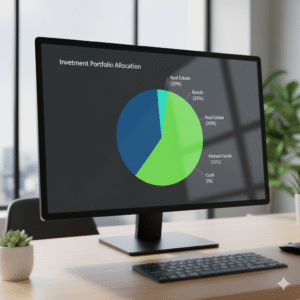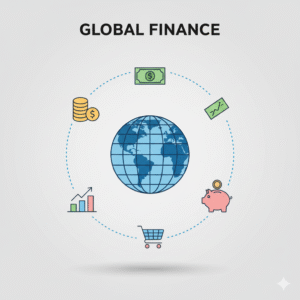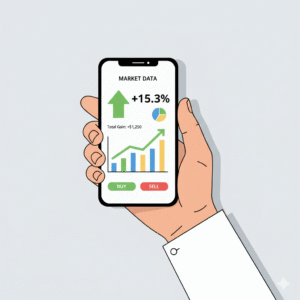What are IPOs?

You’ve likely seen the headlines. A hot new tech company has its “IPO,” and suddenly the founders are billionaires, and the stock price soars on its first day of trading. The news is filled with excitement, and it sounds like a thrilling, money-making event.
But what exactly is an IPO? How does a private company, known only to its customers and early investors, suddenly become a household name traded on the New York Stock Exchange? And more importantly, is it an opportunity for the average investor, or a high-risk game best left to the professionals?
An Initial Public Offering (IPO) is one of the most significant moments in a company’s life. It’s their “coming-out party” on the world’s financial stage. This guide will walk you through everything you need to know about IPOs, from why companies do them to the intricate process involved, and the serious risks every beginner must understand.
Why Do Companies Go Public? Understanding the Motives Behind an IPO

Before a company has an IPO, it is “privately held.” This means its ownership is restricted to a small group of founders, employees, and early-stage investors like venture capitalists. You can’t just log into a brokerage account and buy a piece of the company.
The decision to transition from private to public is a monumental one, driven by several powerful motivations.
1. To Raise Massive Amounts of Capital
This is the primary reason for most IPOs. A company can only raise so much money from private investors. By selling shares to the public, a company can access a vast pool of capital, raising hundreds of millions or even billions of dollars in a single event. This influx of cash can be used for:
- Expansion: Building new factories, opening stores in new countries, or scaling up operations.
- Research & Development (R&D): Funding the creation of new products and technologies.
- Paying Down Debt: Strengthening the company’s balance sheet by eliminating costly loans.
- Acquisitions: Buying other companies to gain market share or new technology.
2. To Provide an “Exit” for Early Investors and Employees
Imagine being an early employee at a startup. For years, a significant part of your compensation might have been in the form of stock options or shares. While the company is private, those shares are illiquid—they are valuable on paper but can’t easily be converted to cash.
An IPO provides a marketplace for these shares. It allows the founders, employees, and venture capitalists who took a risk on the company in its early days to finally sell some of their stake and realize a significant financial return. This is often referred to as a liquidity event.
3. To Increase Public Profile and Credibility
Going public is a major marketing event. The process generates immense media attention, putting the company’s name in front of millions of potential customers. Being listed on a major exchange like the NYSE or NASDAQ also lends an air of prestige and stability to the business, which can help in attracting top talent and securing better terms with partners and lenders.
4. To Create a Currency for Future Use
Publicly traded stock can be used like currency. If the company wants to acquire another business, it can offer the target company a combination of cash and its own stock, a deal that is often more attractive than cash alone.
The IPO Journey: How a Private Company Gets to the Stock Exchange
The road from a private company to a public one is a long, complex, and expensive process that can take six months to over a year. It involves a team of bankers, lawyers, and executives. Here are the key steps:
Step 1: Hire the Underwriters
A company doesn’t go public alone. It hires one or more investment banks to act as underwriters. These banks are the lead managers of the entire IPO process. Their job includes:
- Valuation: Helping the company determine how much it’s worth and what the initial stock price should be.
- Due Diligence: Conducting a thorough investigation of the company’s finances and business operations to ensure everything is in order.
- Marketing: Promoting the stock to large, institutional investors.
- Regulatory Filings: Preparing and filing the mountain of necessary paperwork with the government.
Step 2: The S-1 Filing with the SEC
This is a critical step. The company and its underwriters prepare a formal registration document, called an S-1 Prospectus, and file it with the U.S. Securities and Exchange Commission (SEC).
Think of the S-1 as the company’s official autobiography, written by its lawyers. It’s a massive document that contains everything a potential investor would need to know, including:
- A detailed description of the business and its history.
- Its audited financial statements (revenue, profits, losses, debt).
- Biographies of the executive team.
- A thorough discussion of the risks facing the business (this section is a must-read for any potential investor).
The SEC reviews the S-1 to ensure the company has provided full and fair disclosure. The SEC does not approve the IPO as a “good investment”; it only verifies that the company has followed the rules of disclosure.
Step 3: The “Roadshow” and Building the Book
Once the S-1 is filed, the company’s executives and the investment bankers go on a roadshow. This is an intense series of presentations given to large institutional investors—like mutual funds, pension funds, and hedge funds—across the country.
The goal is to gauge interest and persuade these big players to buy large blocks of shares. The bankers “build a book” of orders, getting a sense of the demand for the stock at different price points.
Step 4: Pricing and Allocation
On the night before the IPO, the company and its underwriters make a final decision: they set the official IPO price. This is the price at which the institutional investors will purchase their allocated shares directly from the company.
Step 5: The Big Day
The next morning, the company’s stock begins trading on a public exchange (like the NASDAQ or NYSE) under its own unique ticker symbol. From this moment on, anyone—including retail investors like you—can buy and sell the shares on the open market. The price is now determined by the forces of supply and demand.
The Investor’s Dilemma: The Allure and Risks of Buying IPO Stocks

The media often focuses on the “IPO pop”—the surge in a stock’s price on its first day of trading. It’s not uncommon for a stock priced at $20 in the IPO to open for trading at $30 and close at $40. This potential for quick gains is what makes IPOs so alluring. But for every success story, there is a cautionary tale. IPO investing is fraught with risk for beginners.
The Major Risks You Must Consider
- Hype vs. Reality: IPOs are marketing events. The company and its bankers have every incentive to generate as much positive buzz as possible. This can lead to an initial stock price that is inflated and disconnected from the company’s true long-term value.
- Extreme Volatility: IPO stocks are notoriously volatile. Their prices can swing dramatically in the first few weeks and months of trading as the market struggles to figure out what the company is actually worth.
- Lack of a Public Track Record: While the S-1 provides historical data, the company has no track record of operating under the intense scrutiny of public markets, with the pressure to report quarterly earnings and satisfy public shareholders.
- The “Lock-up” Period: Early investors and insiders are typically barred from selling their shares for a “lock-up period,” usually 90 to 180 days after the IPO. When this period expires, a flood of new shares can hit the market as insiders cash out, potentially driving the stock price down significantly.
- Information Asymmetry: The big institutional investors who buy into the IPO at the initial price have had direct access to the company’s management during the roadshow. Retail investors buying on the open market are often the last to the party and have the least information.
How Can a Regular Person Invest in an IPO?
Historically, getting shares at the official IPO price was nearly impossible for average investors; it was a privilege reserved for the big institutions and high-net-worth clients of the underwriting banks.
This has started to change, though it’s still challenging. Some modern brokerage firms, like Robinhood and SoFi, have created platforms that aim to democratize IPO access, allowing their users to request an allocation of shares at the IPO price. However, the number of shares available is usually very limited, and there’s no guarantee you’ll get any.
For most people, the only way to invest in an IPO is to wait until the stock begins trading on the secondary market and buy it just like any other stock. The downside is that if there is a big first-day “pop,” you will have already missed out on those initial gains and will be buying at a potentially inflated price.
Beyond the Traditional IPO: A Look at Direct Listings and SPACs

In recent years, some companies have opted for alternative ways to go public that sidestep the traditional, costly IPO process.
- Direct Listing (DPO): In a direct listing, a company doesn’t hire underwriters to sell a new block of shares. Instead, it simply allows existing, privately-held shares from employees and early investors to be listed and traded directly on a stock exchange. No new capital is raised for the company. This process is less expensive and avoids share dilution, and it was used by companies like Spotify and Slack.
- SPACs (Special Purpose Acquisition Companies): A SPAC is a “blank-check company” with no commercial operations. It is formed solely to raise capital through an IPO for the purpose of acquiring an existing private company. The private company being acquired then becomes publicly traded. This offers a faster, and sometimes cheaper, path to the public markets, but it has faced criticism for a lack of transparency and often poor post-merger performance.
Should You Invest in IPOs? A Checklist for Beginners
Before you get swept up in the hype of the next big IPO, ask yourself these questions:
- Have I read the S-1 Prospectus? Specifically, have I read the “Risk Factors” section to understand the company’s biggest challenges?
- Do I understand the business? Can I explain in simple terms how this company makes money and what its competitive advantage is?
- Is the company profitable? Many hot IPOs are for companies that are growing fast but losing massive amounts of money. This is a significant risk.
- Am I chasing the hype? Am I buying because of a compelling long-term business case, or because I’m afraid of missing out (FOMO) on a first-day pop?
- Can I afford to lose my entire investment? Given the high risks, you should only invest money in an IPO that you are fully prepared to lose.
A much safer strategy for most investors is to wait. Wait for the IPO hype to die down. Wait for the lock-up period to expire. Wait for the company to report a few quarters of earnings as a public entity. This will give you a much clearer picture of the business and allow you to make an investment decision based on fundamentals, not speculation.
IPOs as a Piece of the Investment Puzzle
Initial Public Offerings are a vital part of the financial ecosystem. They fuel innovation, reward entrepreneurs, and give the public a chance to own a piece of dynamic, growing companies. However, they are not a guaranteed ticket to quick riches.
For beginner investors, it’s best to view IPOs with a healthy dose of skepticism and treat them as the high-risk, high-reward propositions they are. Instead of chasing the next hot debut, focus on the time-tested principles of building a diversified, long-term portfolio of established, quality businesses. The most reliable path to wealth isn’t found in the frenzy of an IPO’s first day, but in the patient compounding of value over many years.







